Archive for the “IYNF” Category
 Posted by: Diane in IYNF
Posted by: Diane in IYNF
Part Five: Cashmere
Cashmere is one of the most renowned luxury fibres, with wonderful qualities of lightness, warmth and drape. It is the very fine under down of a goat, and can potentially be produced by any breed except the Angora (which produces mohair). Cashmere is a type of fibre, rather than a particular breed and refers to any goat down which meets the exacting grade of being less than 18.5 microns in diameter.
The finest Cashmere producing goats were traditionally found in Mongolia and other parts of central Asia, however, with careful breeding they are now becoming more common in many parts of the world. China, Mongolia and Iran are still the leading producers but there is a firm industry in Australia and New Zealand and production in the US and the UK is also increasing.
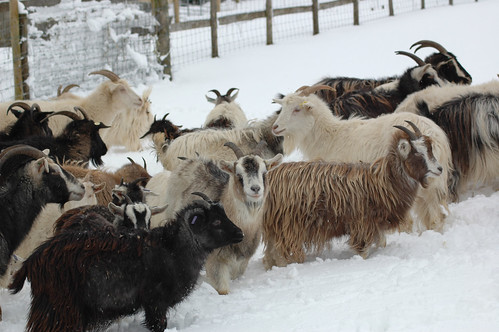
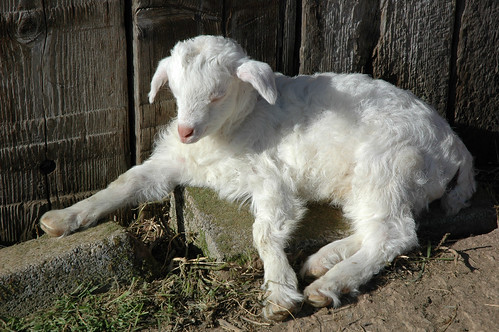
(Cashmere goats at Westcott Farm in Devon, photos by Lesley Prior)
Harvesting
Goats are shorn or combed once a year in the spring, a time when they will naturally shed the down grown for the cold winter months. In some areas, the shed fibre is collected from the rocks and bushes where the goats have been grazing. Each adult goat produces only a small amount of down, up to 8 ounces per year.
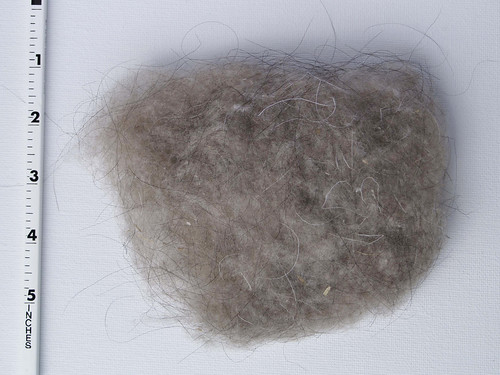
After washing, the fine down must be separated from the hairy outer coat and this is generally now done by machines. I de-haired a tiny amount of the fibre which Lesley kindly sent me and it took me about half an hour! Definitely a painstaking job. This labour-intensive process is one contributor to the high price of Cashmere fibre.
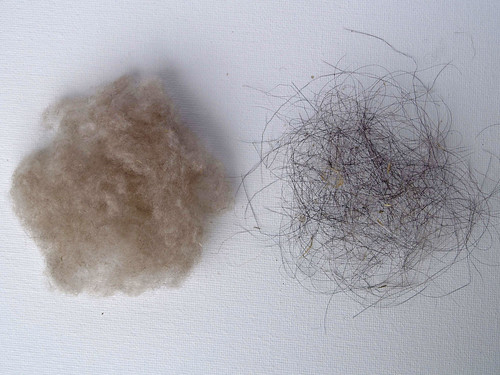
Structure and Characteristics
The finest Cashmere can have a diameter of as low as 14 microns, thus there can be still quite a range in quality between different sources of fibre. Poorly processed Cashmere may also still contain some guard hairs which will make spinning unpleasing, so be sure to obtain fibre from a reputable dealer.
Once it has been de-haired, the Cashmere down is processed in the same way as wool. It can be carded and sold as a ‘cloud’, or processed into top. Cashmere should be at least 1.25 inches long, and best quality Cashmere has a strongly defined crimp structure, making it springy and able to hold its shape. This crimp also contributes to the fibre’s warmth as it creates many air pockets in the yarn.
Cashmere has an indistinct, smooth scale structure and will not easily felt. With fulling, yarn or fabric made from cashmere will expand and ‘bloom’ creating a wonderful surface halo and soft handle.
Cashmere for Handspinners
Down fibres are generally best spun with a long-draw method and are popular with users of support spindles. A very light drop spindle (shown below, Bosworth featherweight - 14g), or a wheel set with minimal take-up will also be suitable and will not pull the yarn apart as you create it. The shortness and fineness of the fibres calls for a fair amount of twist, and low diameter. If you wish to create a thicker yarn, it will be more stable if you spin several singles and ply them together.
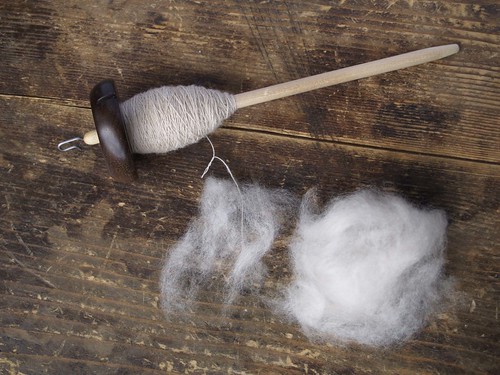
Cashmere blended with other fibres will add a lovely warmth and halo to your yarn and can make a small amount of expensive fibre go a lot further. Even the smallest proportion, 10% or less, is very noticeable in the handle of the finished yarn.
With special thanks to Lesley from Devon Fine Fibres who sent me the raw cashmere fibre and the gorgeous goaty pics!
Sources/further reading
MacKenzie McCuin, Judith ‘The Intentional Spinner’, Interweave press, 2009.
Albright, Barbara “The Natural Knitter�?, Potter Craft 2007
Russo, Robin. Class notes, SOAR 2008.
Devon Fine Fibres http://www.devonfinefibres.co.uk/
 2 Comments » 2 Comments »
 Posted by: Diane in IYNF
Posted by: Diane in IYNF
Part Four: Mohair
Mohair is the fibre obtained from the Angora goat, named for the region in Turkey where they were first domesticated. The fibre is well known for its incredible shine and beautiful fluffy halo. It’s no wonder: the word Mohair derives from the Arabic word ‘mukhayyar’, meaning choice or select.
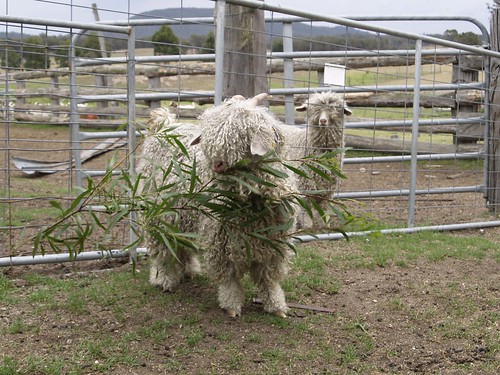
(Daisy, just before shearing)
Angora goats (actually recently renamed Mohair goats) are friendly and docile and make lovely fibre pets! Although originally kept closely guarded and protected in Turkey, the breed was eventually exported in the 19th century and the goats are now farmed in many parts of the world including Africa, the United States and Australia.
Harvesting
Mohair grows very quickly (about one inch per month) and Angora goats are generally shorn twice a year, in the spring and autumn. Although goat hair contains no lanolin, it does have natural oils which are easily washed out with mild soap. Mohair is generally carded before spinning and is often blended with other fibres to add strength and lustre to a mix.
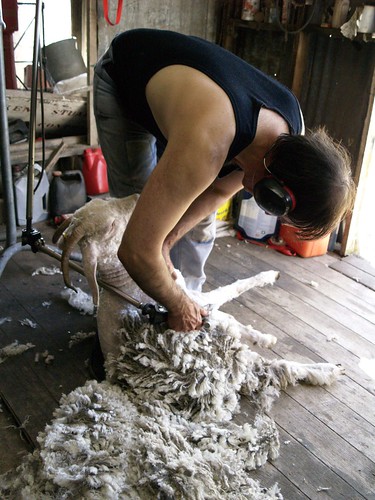
Structure and Characteristics
Mohair has a very smooth surface, lacking the scales found on wool. This smoothness reflects light, giving mohair its incredible lustre. The fibres are long and straight, with a curly wave. Young kids usually develop close ringlets, a sign of fineness, this curl becomes less pronounced as the goat ages.

(Adult mohair - top, and kid)
Unlike sheep and many other fibre animals, Mohair goats produce different qualities of fibre as they get older. Finest kid mohair comes from the first, second and occasionally third clips, fibres are between 23 and 30 microns. This is the best fibre for knitting yarn, it is soft and produces a lovely halo. Clips from older goats can range up to 40 microns. As the strength and lustre of the fibre increases with age, these grades are excellent for upholstery fabrics or to blend with other fibres to add strength and shine.
Varieties
The different Angora goat varieties (including for example, South African and Australian strains) have only subtle distinctions. However, there has been much interest in recent years in developing naturally coloured Angora goats, and fibre can now be obtained in a range of colours including greys, blacks and reds. For more information, visit the Colored Angora Goat Breeders Association.
Mohair for Handspinners
Mohair is a fibre which many spinners avoid, partly because they fear it will be ‘difficult’, partly due to experience with prickly mohair, and perhaps partly because they’re just not quite sure what to do with it! I have to admit to being a little bit in love with Mohair. Having access to a flock of the cutest goats on the planet helps of course, and I also love the incredible jewel colours mohair gives and the subtle halo effect that can be created.
The smoothness of mohair, which gives it its shine, does make it a very slippery fibre to work with. It needs a lot of twist to hold it together if spun on its own, but once there is enough twist, the fibres will lock safely in place and the ends will pop out and bloom.

(carded Mohair rolag ready for spinning)
I personally prefer to blend mohair with other fibres, usually wool. It is fabulous in socks for a bit of extra warmth and strength (see my Jo pattern and tutorial in Spin! Series 1), and is gorgeous blended with wool in a woven project where it adds lustre and drape to the fabric.
Card or blend mohair with handcards, and spin fine yarns with a fairly high level of twist. Mohair has no memory, so avoid using it straight up for garments which might sag and stretch. Also, use a larger knitting needle size, or weaving sett, to ensure that the mohair fibres have room to bloom.

* With thanks to Daisy, Bonsai and the rest of the flock at the farm for posing for photos and giving up their fleeces for us again this year!
Do you have questions? What are your experiences with Mohair – like it? Love it? Leave a comment or come by the Lingr chatroom on Sunday evenings.
Sources/further reading
MacKenzie McCuin, Judith ‘The Intentional Spinner’, Interweave press, 2009.
Albright, Barbara “The Natural Knitter�?, Potter Craft 2007
Russo, Robin. Class notes, SOAR 2008.
http://www.cagba.org/ Colored Angora Goat Breeders Association
 6 Comments » 6 Comments »
 Posted by: Diane in IYNF
Posted by: Diane in IYNF
Part Three: Cotton
Cotton has a long and fascinating history in the textile world and today still counts for by far the largest portion of the commercial natural fibre industry. It is a fibre which has often been at the centre of things; Cotton Bonds helped to fund the South in the American Civil War and the spinning of cotton was integral to Ghandi’s campaign to free India from English rule, re-igniting an industry over 3000 years old. Fragments of cotton textiles have been dated back to the stone age and it has been a popular fibre choice for clothing all over the world throughout history.


(Cotton flower, and naturally coloured cotton boll ready for picking, photos by Phreadde Davis)
Harvesting
Cotton is a perennial plant, but nowadays is usually grown commercially as an annual, with plants being resown each year. It grows best in hot, dry climates and some varieties can reach up to 6 feet tall. The flowers develop into pods in which the seeds are protected by a mass of fibres, up to 4000 on each seed. As the fibres grow, they coil and twist, when the plants mature the fibres straighten, causing the pods to burst open.
Cotton is picked commercially by machine, either stripping the seeds and fibres from the pods, or taking the whole boll. Seeds are removed by a process called ginning, and the cotton is carded or combed in preparation for spinning. Handspinners often spin cotton straight from the seed, saving on labour if the cotton is home-grown.

(Cotton seeds ready for spinning)
Structure and Characteristics
Cotton fibres grow layer upon layer of cellulose in hollow cylindrical tubes, when picked the tubes then collapse into flat ribbons. This tubular, layered structure is what gives cotton it’s excellent absorbant qualities. The many coils and twists in the fibres create a crimp and springiness rather like that of a fine wool, which makes cotton easier to spin than smoother fibres. Cotton is stronger than wool, but weaker than silk or linen. It burns easily and is very susceptible to damage from acids and mildew. Fibres will also weaken with prolonged exposure to sunlight.
Cotton fibres are generally in the range of 12-20 microns in diameter, and can vary in length from 0.5 to 2.5 inches. The fibres have good luster which can be greatly increased through the process of Mercerization which plumps and straightens the fibres creating a lovely surface sheen.
Varieties
There are many different varieties of cotton, found in tropical and subtropical climates all over the world. It is a member of the Gossypium or Mallow family (source of our word ‘marshmallow’) which also includes Hibiscus and Hollyhocks.
Egyptian cotton is popular for luxury cotton products, its particularly long smooth staple is softer and more durable than American (Pima) cotton. Other varieties include Sea Island, Peruvian, and Indian, but these account for very little of the commercial industry.
Many people are becoming concerned about the use of pesticides, insecticides and herbicides used in cotton growing (up to 25% of world use is for cotton crops) and are turning to organic varieties. Availability of organic fibres, yarns and finished garments is increasing rapidly with demand and it is now relatively easy to find organic alternatives. As part of this movement, we are seeing the reappearance of many beautiful naturally coloured cottons. A pioneer in this area, Sally Fox, has worked at researching and developing many varieties of natural coloured cottons in spite of resistance from the commercial white cotton industry.
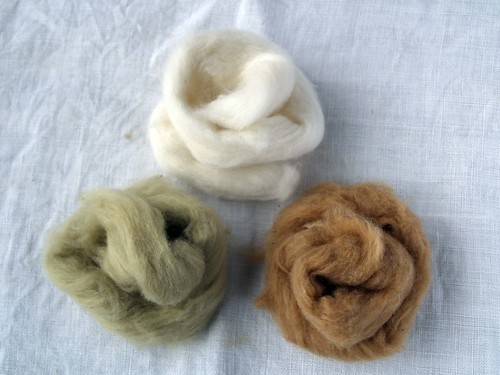
(Organic cotton fibre in natural white, tan and green)
Cotton for Handspinners
Cotton is an extremely short fibre and is most successfully spun with a long draw or point-of-twist technique. A fine thread with lots of twist is normal, and thus a high ratio is needed. The traditional tool for spinning cotton, the Charkha, has an accelerated pulley system which allows for ratios of up to 100:1. Cotton can be successfully spun on a spinning wheel, however, with a high ratio and tension set to low, or a light drop or supported spindle.
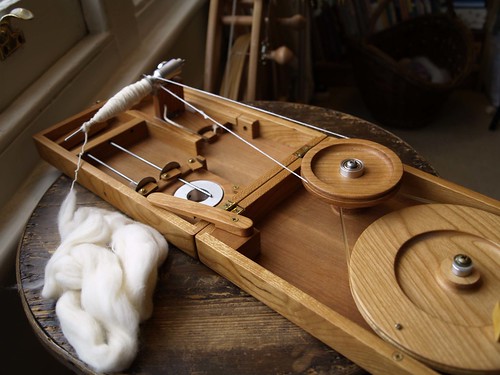
(Book Charkha made by Jonothan Bosworth)
Cotton is often boiled after spinning to set the twist and remove any last traces of wax (this wax is generally removed in processing). Coloured cottons should be boiled as this process intensifies the colours, creating a much more striking effect.
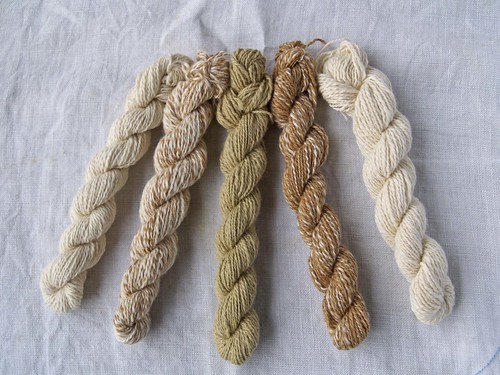
(Skeins of Charkha-spun cotton)
With special thanks to Phreadde Davis who taught me to spin cotton, and provided the pictures of cotton plants for this article. Check out her blog at http://cottoncrop.blogspot.com/ and say hello from me!
Do you have questions? What are your experiences with cotton – like it? Love it? Leave a comment or come by the Lingr chatroom on Sunday evenings.
Sources/further reading
Ross, Mabel “Essentials of Yarn Design�?, 1983
Chadwick, Eileen “The Craft of Handspinning�?, Batsford Ltd, 1980.
MacKenzie McCuin, Judith ‘The Intentional Spinner’, Interweave press, 2009.
Albright, Barbara “The Natural Knitter�?, Potter Craft 2007
Wayland Barber, Elizabeth “Women’s Work – The First 20,000 Years�?, Norton, 1994.
BBC Television: “The Ascent of Money�? Episode 2, 2008.
Columbia Pictures: “Ghandi�?, 1982.
http://www.foxfibre.com/ Fox Fibre – Colour by Nature, Sally Fox’s website
http://www.spinningtheweb.org.uk ‘Spinning the Web – The Story of the Cotton Industry
http://en.wikipedia.org/wiki/Cotton Wikipedia - Cotton
 2 Comments » 2 Comments »
 Posted by: Diane in IYNF, Spin-In
Posted by: Diane in IYNF, Spin-In
Part 2: Angora
Angora Rabbits, like the goats of the same name, originated in Turkey near Ankara, the city for which they are named. They are large and docile and extremely popular as pets, as well as being the source of a luxurious silky fibre. It is said that they were a favourite of French royalty in the 18th century, and frankly, who wouldn’t want one of these funny-faced fluff-balls around?

Harvesting
Depending on the breed, Angora hair can be either shorn or plucked, usually four times per year. During this time the coat of some breeds can grow up to 4 inches in length. Naturally shedding fur is gently combed or plucked from the coat, leaving behind any longer guard hairs which may be present. Some breeds, including the German angora, need to be shorn, and this also occurs four times per year. Angora fur is very clean and doesn’t usually need any other preparation before spinning, in fact, it is very common at fibre festivals to see a spinner with a bunny on her lap – spinning straight from handfuls of the coat (pluckable only I hope!).
Fibre Characteristics
Angora is soft, smooth and silky, and depending on the breed, can vary in length from around 1 – 4 inches. It is very light and fine, usually around 13-15 microns, and is quite inelastic. Much of the finest Angora is very short and slippery and it is often blended with other fibres to make it easier to spin. Angora is also incredibly warm, eight times warmer than wool, meaning that even a small amount will add a lovely warmth and halo to a blended yarn. Use a larger size needle than usual for knitted garments to allow space for the halo to develop.
Varieties
There are many breeds of Angora rabbits. The American Rabbit Breeders’ Association recognises four main ones: English, French, Giant and Satin, which also have many varieties within the breed, each with differing characteristics. The English and French breeds are very common. Also very popular, but with its own association is the German Angora, like Billy pictured above. German Angora is generally not quite as fine as the French or English, and is shorn rather than plucked. There is also an Asian breed, which accounts for a growing commercial industry in Nepal and surrounding regions.
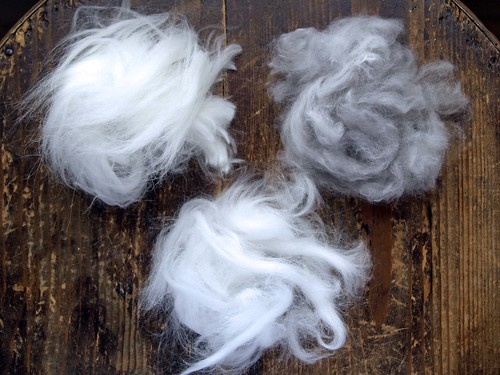
The three samples above are (clockwise) clipped German Angora, sent to me by Billy’s owner, Heidi Kim; plucked grey Angora, I picked this up in Australia and don’t know the origin, but it is quite different to the other two; plucked English angora, from a local fibre retailer.
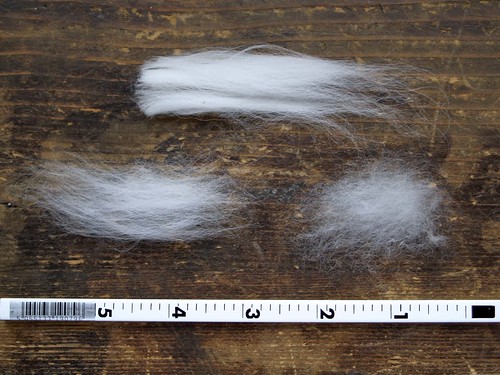
When looking at the individual locks, it is easy to see the remarkable differences between each one (top: German; left: English; right: grey).
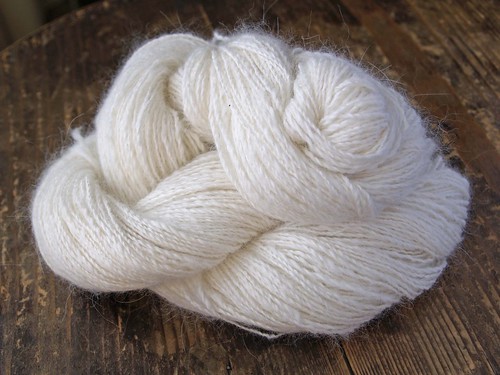
Heidi also sent me this gorgeous skein of handspun Angora yarn, pop over to her blog for more pics of her bunnies and say hello from me!
Do you have questions? What are your experiences with Angora – like it? Love it? Leave a comment or come by the Lingr chatroom on Sunday evenings.
Sources/further reading
Albright, Barbara. “The Natural Knitter�? Potter Craft 2007
Field, Anne. “The Ashford Book of Spinning�? Shoal Bay Press, revised 1999
Wikipedia.org “Angora Rabbit�?
http://www.arba.net/ American Rabbit Breeders’ Association
http://www.himalayan-healthcare.org/
http://hifeed.org/angora_2.html
 4 Comments » 4 Comments »
 Posted by: Diane in IYNF, Spin-In
Posted by: Diane in IYNF, Spin-In
Being a bit of a natural fibre junkie, I was thrilled to learn that 2009 would be a year dedicated to promoting them. This series of articles will cover twelve natural fibres over the year, I hope you enjoy them! Read more about the International Year of Natural Fibres at http://www.naturalfibres2009.org/.
Part One: Wool
Wool is the general term for the hair grown by sheep. For millennia, it has been a prized natural fibre, although nowadays it accounts for only around 5% of the world’s fibre consumption. Fragments of wool fabric up to 6000 years old have been found in Egypt and Europe, and historical records emphasise the value of wool as a trading commodity across Europe, Northern Africa and the Middle East. No doubt these ancient spinners and weavers enjoyed wool for much the same reasons that we do now. A soft, light, readily-renewable fibre, it is warm when wet, fire resistant and takes dye colour beautifully. It has huge variety in type allowing for a multitude of uses and is pleasant to work with. What’s not to like!
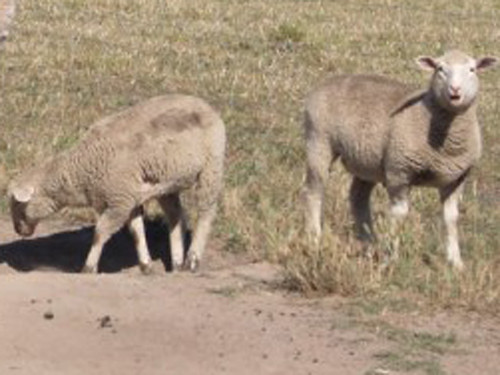
Harvesting
Although some primitive breeds still shed their fleece in clumps, in general the wool is clipped off with shears on a regular basis, usually once per year. The protective lanolin in the fleece is washed out and the fibres are carded or combed to prepare them for spinning. The first fleece a lamb produces (called a hogg, or hoggit fleece) is often particularly fine in quality, but subsequent fleeces do not vary remarkably; the grade of fleece from a particular animal will continue to be of similar quality until old age. Thus, if you happen across an extra good fleece, and you know the animal it came from, it is worth keeping the information ready for next year’s shearing time.
Structure
Wool is a protein fibre and comprises an outer sheath and inner cortex. Covering the sheath, or cuticle is a thin layer of overlapping scales. These scales enable the fibre to matt and felt, creating dense, warm cloth, and they are in most cases what people with wool sensitivities are reacting to. Superwash wools have been treated to either smooth or remove these scales; treated wool can feel less ‘prickly’ and is much harder to felt.
Fibre Characteristics
The main characteristics that set wool apart from other hair fibres are its crimp and elasticity. Wool fibres are very strong, even when wet, and can stretch up to another two thirds in length and still return to the original state. This and the natural crimp in the fibres help to create yarn which is soft, lofty and springy. These characteristics, along with the slightly textured surface of the fibres due to the scale structure, make wool an easy fibre to spin as it readily clings to itself to form yarn.
Varieties
Different breeds of sheep can live in widely varying climates and are farmed all over the world. As a hand-spinner or knitter, you will probably have come across many different types of wool. A huge variety of breeds of sheep produce an enormous choice of wools, from the finest Merino right up to the coarse rug wools. A fine Merino may have a micron* measurement of 18, and Bradford Count of 80; a Wensleydale fleece may have a micron of 32, or a BC of around 50. In general, fine wools are shorter and more suited to next-to-skin garments, but are less durable, coarse wools will generally be longer in staple, and will have the durability needed for upholstery fabrics or outer garments. (Below: Polwarth – a fine wool, and English Leicester – longwool).
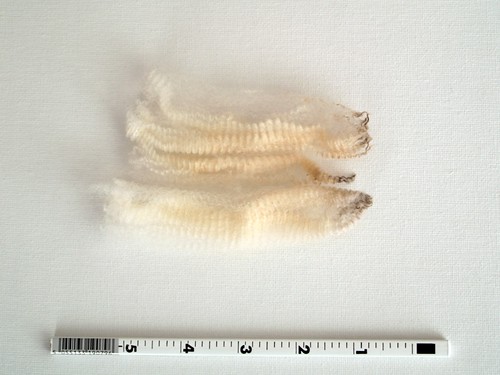

Wool is by far my favourite of all natural fibres. I love its character, the ease of spinning and the way it feels in a knitted or woven garment. It may also have something to do with the little bit of sheep I have in my blood, but whatever the reason, it will almost always be my first choice when I’m looking for something to spin.

Do you have questions? What are your experiences with wool – like it? Love it? Leave a comment or come by the Lingr chatroom on Sunday evenings.
Sources/further reading
Fournier and Fournier, “In Sheep’s Clothing�? Interweave Press, 1995.
Wayland Barber, E., “Women’s Work�? Norton, 1994.
Wikipedia - Wool
* The fineness of fibre is measured in two ways: with a micron measurement – determining the exact diameter of the individual fibre, or with the Bradford Count – a measurement based on the amount of yarn that can be spun from an ounce of fibre.
 6 Comments » 6 Comments »
Not a proper Spin-In today, I’ve been resisting but have finally given in and I’m thoroughly in Holiday Mode. Proper spinning talk will resume on Jan 4. But, I thought I’d share some of the things I have in mind for next year, and invite your input. Not only for Spin-In, but the upcoming Spin! Series 2 as well.
Something I’m really excited about - next year is The International Year of Natural Fibres, read more here. I’ve always been a big supporter of the natural, and I’m really glad this is happening. As part of the Spin-In, I’m going to be presenting a Natural Fibres series, once a month presenting a different fibre with background notes, uses and project ideas. When I started tossing around this idea I thought it would be tricky finding enough - but you’d be surprised! I’m including some fibres on the list that I’ve never spun before so I’m pretty excited about getting to work with those.
Spin! will also be natural fibre based next year, in fact, I’m going to try and exclude man-made as much as I possibly can for the year in my writing and teaching. I’ve started work on the next series, and am happy to be using fibres from some great indie dyers local to me. Look out for previews and patterns before winter’s over!
This all leaves plenty of room for adjustments however, and I’m very happy to have your ideas. Is there anything you’d particularly like to see in Spin! Series 2? in the IYNF Series posts, or another Spin-In? I’ve got 50 posts to play with after all!
Leave a comment, or pop by tonight on Lingr for a chat. I will be there from 5-10pm (ish).
Lastly, please make sure you drop by the blog on Tuesday to collect your Christmas present from me!
 No Comments » No Comments »
|


























 Entries (RSS)
Entries (RSS)